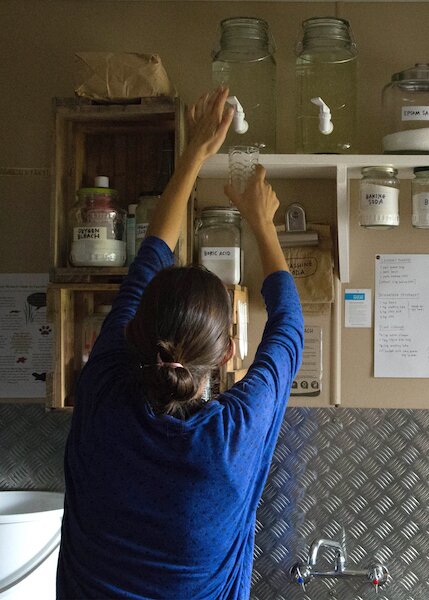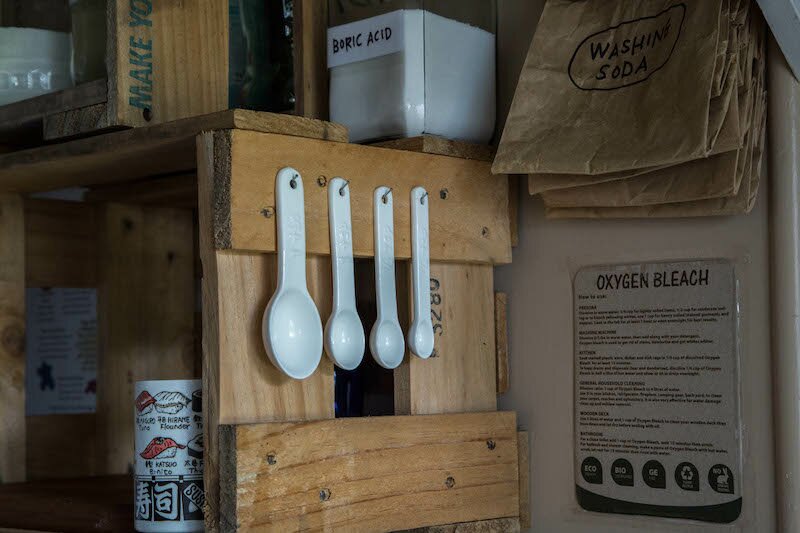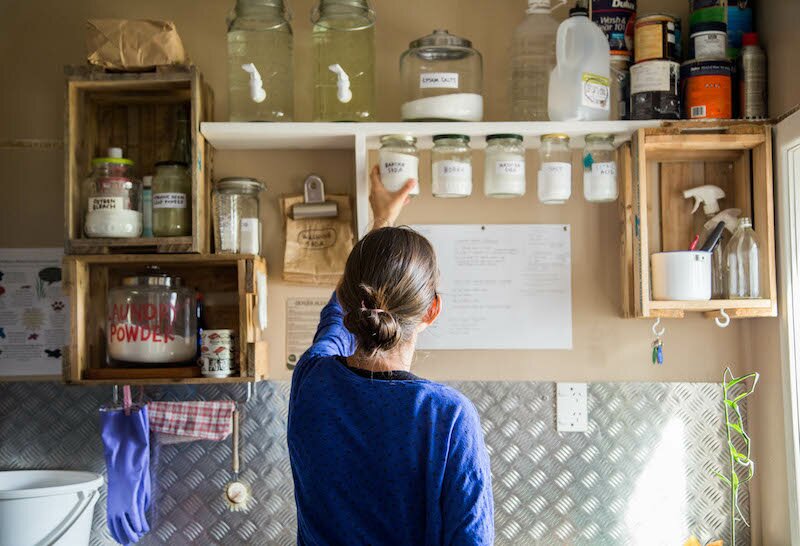When it comes to dangerous chemicals, whether you’re eco-friendly or not, the laundry must be the hub of the house (well, perhaps excepting the garage). We have only just recently attached child-proofing gadgets to our kitchen cupboards, as little Daniel is very inquisitive and likes to go digging around in any little nook and cranny below waist height. Both my husband and I agree they are such a pain, but I guess we should just count ourselves lucky in that we got away without them for so long. Our little dog, Truffle, is not very nosy and never has been, and Stella was a curious but also very cautious toddler so we were fine just keeping a close eye on her.
My feeling, when Stella first started to move about, was that I would rather put my energy into removing hazardous substances from our house than into introducing all sorts of barriers and obstacles between her and them. Thus began the decluttering of our laundry, as I removed all commercially-prepared cleaning products containing ingredients I didn’t recognise from high school science. Most were easy to get rid of, but a couple required extreme self-discipline to part with: Janola bleach gel was one, and Jif cleaner was another. I just assumed that Jif had no match, and I used it for everything that needed a bit of elbow grease to get clean. But I was motivated by principle to get rid of it, so I did. And I’ve never looked back! These days, instead of Jif cleaner (ie. Calcium carbonate, water, sodium dodecylbenzenesulfonate, sodium carbonate, c9-c11 pareth-6, sodium cocoate, sodium bicarbonate, disodium distyrylbiphenyl disulphonate, 1,2 benzisothiazoline-3(2h)-one, perfume), I sprinkle some baking soda on a damp cloth and then pump a couple of squirts of our foaming hand soap on top. This cleans everything in our bathroom, our kitchen and laundry sinks, tea or coffee stained cups; in fact everything and more than Jif cleaned, because it’s safe to ingest.
Nowadays, I mix my own cleaners on a need-to-use basis, using a very small number of basic ingredients. I keep baking soda, borax, and washing soda in glass jars which I’ve mounted to the underside of a high shelf in the laundry (I also have salt and citric acid but don’t use those anymore since we got rid of our dishwasher). Because the lid is screwed to the shelf, I necessarily return the jar after use, meaning it won’t be left lying around on a bench for little kiddies to find. Glass is such a practical storage solution in the laundry because it is inert, but also you can see at a glance if you’re running low on anything as you run out the door.

On the shelf above these are two glass drinks dispensers with spigots, which I have filled with white vinegar and bleach. I bought these dispensers very cheaply from The Warehouse, but they came with really cheap-and-nasty plastic spigots that leached black flakes into the vinegar. So I bought better quality plastic spigots from the brewery aisle of our local Bin Inn for just a couple of dollars, and my clever husband swapped them over for me. They have been trouble-free ever since! No drips, and no gross flakes pouring into our glass. The white vinegar cleans basically everything the baking soda doesn’t. I use vinegar in my washing machine in place of fabric softener, to disinfect surfaces like toilet seats and the kitchen bench, to wipe glass surfaces clean, and in our floor cleaner recipe. It’s so cheap, free of head-spinning fumes like bleach (which I use as little as possible for this reason), and safe to use around kids and pets. Plus, it’s biodegradable, so it’s safe to flush down the drains.

You can see that above our laundry powder, I have a jar of oxygen bleach on our shelf. I use this for soaking cloths and particularly dirty kids’ clothes. It’s great for a whitening, brightening soak, particularly for light coloured clothes. However, it’s a little bit pricey so I’m thoughtful about how and when I use it.
One of my favourite things in our laundry is the set of ceramic measuring spoons we have hanging off little nails on the side of our crate-shelf. I found these at The Warehouse of all places, but unfortunately I haven’t seen them since. I bought two sets: one for the kitchen and one for the laundry. And as it turns out, it’s the best thing for an eco-laundry; having a dedicated set of laundry measuring spoons. That, and a poster on your wall with all your most-used recipes.

On that note, here are our most-used because they are our most successful cleaning recipes:
LAUNDRY POWDER – after many attempts at many different recipes, we finally found Wellness Mama’s recipe for laundry powder and we haven’t been tempted to use anything else since.
Basically, it’s 2 parts borax, 2 parts washing soda, and 1 part grated bar soap. The only soap I use for this recipe is Dr Bronner’s baby mild bar soap. It’s expensive because it’s imported, but it works and one bar goes a long way. After I grate the soap, I pulse it in the blender a few times to make it really fine, almost powdery. I’ve worked out one bar soap equates to about 16 tablespoons, so then I just add 32 Tbsps each of the borax and washing soda. I use only 1½ – max. 2 Tbsp of the laundry powder per load, and then ¼ cup of white vinegar in the fabric softener compartment. If a wash is particularly stinky, I might add a teeny bit of baking soda to it.
Homemade laundry powder only works well when your washing machine is actually clean. Regular cleaning seems to be especially important for front loaders (which we have), which aren’t so good at draining water completely. About once a month, I do a very hot wash with a cup of bleach. Afterwards, I give the tub and seals a wipe with an old towel. Then I do another hot wash with a cup of vinegar. After every wash cycle I always take the dispensing tray out completely and let it air dry to prevent mould build-up on the underside.
NAPPY SOAK
1 Tbsp laundry powder
1 – 2 Tbsp oxygen bleach (sodium percarbonate)
very hot tap water
Stir to make sure powders are dissolved before putting clothes in, if you want to avoid splotchy clothes. I speak from experience.
FLOOR CLEANER – but I admit I don’t mop the floor nearly as often as I should!
This recipe comes from: http://www.food.com/recipe/floor-grease-cutter-cleaner-393210
¼ cup white vinegar
1 Tbsp liquid dish soap
¼ cup washing soda
Fill bucket with hot tap water
SCOURING CREAM (Jif Alternative) & SOAP SCUM CLEANERS
When heavily pregnant and on a mission to ultra-clean our shower so it sparkled, I preferred these recipes: http://healthyblenderrecipes.com
Now that I am no longer heavily pregnant nor obsessing about every speck of dirt and every smear of grease, baking soda and foaming soap work just fine in our shower 😉
DRAIN CLEANER
1 cup baking soda down drain
Pour 1 cup white vinegar in. Watch excitedly as it all fizzes up out of the drain!
Wait 5 minutes, then flush out with hot water.
This is very therapeutic, by the way.
DISHWASHER DETERGENT – when we had a dishwasher, this was our recipe of choice:
http://wellnessmama.com/12217/homemade-dishwasher-detergent/
As with the homemade laundry powder, this only works well when your dishwasher is actually clean!
I also recommend you print out a copy of Wellness Mama’s Guide to Laundry and put it on your laundry wall. Clearly I need to invest in a bottle of hydrogen peroxide. It’s on my list of things to work toward…!
…PSSST! Love the idea of the glass laundry dispensers? Well, I designed some just for you – they hold 5L of liquid in a lead-free, durable glass clip-top vessel with a food-grade plastic spigot mounted as low as possible so you can get (almost) every last drop out. Optional labels of ‘vinegar’ and ‘bleach’ are bead-blasted onto the glass so they will look as good as new, forever! Available from the Mrs Goodness Shop – go have a look! 😉

Amaaazing organisation!
Great article, loved reading it. Where can I get ceramic spoons from? Could not find it at Briscoes.
Hi, thanks for the nice feedback 🙂 Those ceramic spoons were part of the Ecology brand of homewares, and I noticed that they changed their products a few months’ ago (they’ve ditched the colours and gone for plain white, and they’ve changed the font on their labels). Briscoes had the spoons for sale as clearance items, so perhaps they’ve been discontinued? It would be a bummer if they have because they’re lovely and I haven’t seen them anywhere else. Having said that, I have chipped a few, so perhaps stainless steel spoons would be a more durable way to go…
So inspiring. This is on my next to-do list as I also get major headaches using commercial cleaning supplies. Well done.
It doesn’t surprise me that you get headaches from commercial cleaning products; I’m so unused to the strong smells of chemical cleaning products now that I feel faint when I pass that aisle in the supermarket! Glad you’re inspired to do some purging… 😉